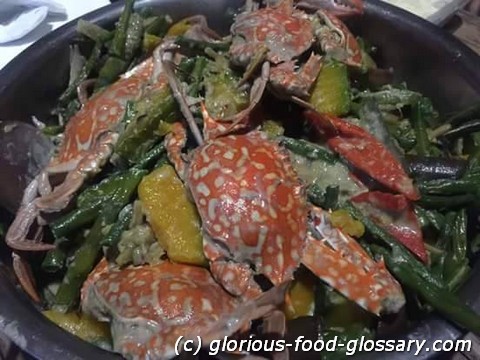Glossary G
English: Fried Rice / Deutsch: Gebratener Reis / Español: Arroz frito / Português: Arroz frito / Français: Riz frit / Italiano: Riso fritto /
Ginarep refers to a Filipino food, particularly of the Bicol Region made of sauteed shrimp and grated fresh corn with garlic, tomatoes and onions with either vegetable or chicken broth. Malunggay leaves are added towards the end of cooking.
Ginarep is called in another Philippines province, Pampanga "Suam na Mais", but instead of Malunngay leaves, they add pepper leaves or Dahon ng sili.
English: Ginataan / Deutsch: Ginataan / Español: Ginataan / Português: Ginataan / Français: Ginataan / Italiano: Ginataan /
Ginataan, often referred to as "Ginataang," is a delectable Filipino culinary tradition that involves cooking with coconut milk as a primary ingredient. This rich and creamy concoction is the foundation for a wide array of dishes, both savory and sweet, in Filipino cuisine. In this article, we will delve into the significance of Ginataan, its various culinary applications, potential risks associated with its consumption, historical insights, and legal considerations. We'll also explore similar dishes from other cultures.
Ginataang Alimasag is one of the dishes from the Philippines made from Blue crab (Alimasag) and assorted vegetables, such as String beans (Sitaw), Eggplant (Talong) and Pumpkin or Squash (Kalabasa) sauteed with chopped onions and garlic and cooked with or simmered in Coconut milk (Gata), hence it is called Ginataan.
Please see the article on the List of the Philippines Cooking Methods in Filipino (Tagalog Dialect).

Deutsch: Kamansi in Kokosmilch / Español: Kamansi en leche de coco / Português: Kamansi em leite de coco / Français: Kamansi Au lait de coco / Italiano: Kamansi nel latte di cocco
Ginataang Kamansi in the food context refers to a traditional Filipino dish made from breadnut (kamansi), which is cooked in coconut milk (gata). Kamansi, known scientifically as Artocarpus camansi, is closely related to breadfruit and jackfruit, and is valued for its starchy, edible seeds and flesh. This dish is a part of the broader category of "Ginataan" recipes in Filipino cuisine, which involves cooking various ingredients in coconut milk, often resulting in creamy, rich, and flavorful dishes.
Deutsch: Ginataang Labong / Español: Ginataang Labong / Português: Ginataang Labong / Français: Ginataang Labong / Italiano: Ginataang Labong
Ginataang Labong in the food context refers to a traditional Filipino dish made from bamboo shoots (labong) cooked in coconut milk (gata). This dish is a staple in Philippine cuisine, known for its creamy texture and rich, slightly spicy flavor. The bamboo shoots provide a tender yet crisp contrast to the creamy sauce, making it a beloved comfort food. Often, shrimp, pork, or dried fish are added to the dish for extra flavor and protein, along with spices like garlic, onion, ginger, and sometimes chili peppers for heat.
Deutsch: Ginataang Papaya / Español: Ginataang Papaya / Português: Ginataang Papaya / Français: Ginataang Papaya / Italiano: Ginataang Papaya
Ginataang Papaya in the food context refers to a traditional Filipino dish where unripe papaya is cooked in coconut milk (gata). This dish is a savory and creamy stew, often enhanced with the addition of shrimp, fish, or pork and spiced with garlic, onion, ginger, and sometimes chili peppers for heat. The use of green, unripe papaya gives the dish a mild sweetness and a slightly crisp texture, which contrasts beautifully with the rich, creamy coconut milk.
Deutsch: Ginataang Santol und Garnelen / Español: Santol y camarones en leche de coco / Português: Santol e camarão em leite de coco / Français: Santol et Crevettes Au lait de coco / Italiano: Santol e gamberi in latte di cocco
Ginataang Santol at Hipon in the food context refers to a traditional Filipino dish that combines santol (cottonfruit) and shrimp cooked in coconut milk. This dish is a unique Blend of flavors, showcasing the sourness of the santol fruit with the sweetness of shrimp, all balanced within the rich, creamy texture of coconut milk. The santol fruit is peeled and grated or finely chopped, then cooked with shrimp, garlic, onion, ginger, and sometimes chili peppers to create a savory, slightly spicy, and aromatic dish.
